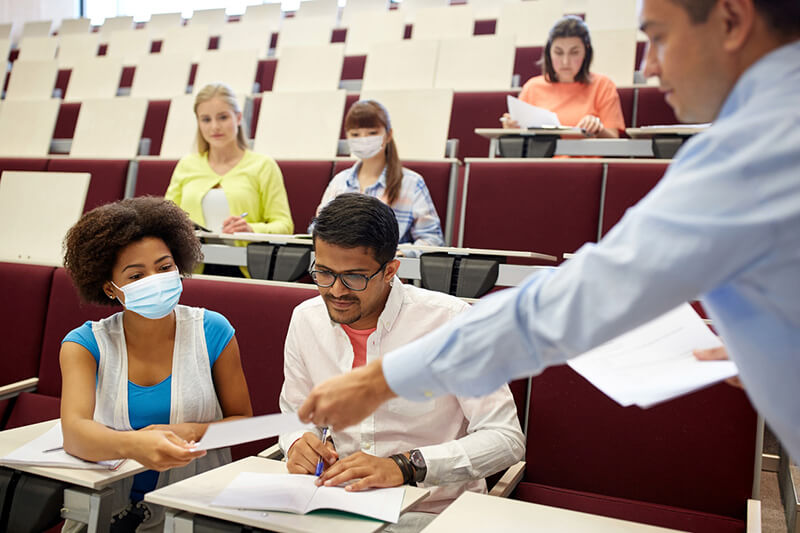This summer, Tara E. will fulfill her dream, becoming a family care doctor in her home state of Michigan.
“Number one, it’s everything,” the 30-year-old OnlineMedEd user says, of her dream residency. ”Each and every case you see every day is different – it keeps you on your toes.
“It’s a field that is changing all the time. Then, secondly, the relationship you get to build with your patients is [really great]. ”
Along with looking after Michigan families, Tara, who was born and raised in Iraq, will join the bulging ranks of foreign-born medical professionals practicing in the United States.
In 2018, Reuters reported that almost 17 percent of 164,000 healthcare professionals in the U.S. weren’t born here. A further breakdown of U.S. census data showed that around 29 percent of physicians were born outside the States, while close to 24 percent of dentists were immigrants.
Despite the large numbers, the recent strain of the COVID-19 crisis, and the additional fact that foreign-born doctors are playing an increasingly large role in rural communities around the U.S, potential immigration policies, and changing visa rules, have created widespread uncertainty amongst the medical community.
That uncertainty, especially amongst those wanting to practice in the U.S., is threatening to spill over into something more troubling if the pandemic is still far from its peak.
“Healthcare workers … are being drawn away from their vital work, instead busy with lawyers and [human resources] personnel at their hospital, working on renewing their immigrant filings,” Leon Rodriguez, the director of the United States Citizenship and Immigration Services (USCIS), told The Hill recently.
The majority of immigrant doctors seeking to practice in the States must attain certification from the Educational Commission for Foreign Medical Graduates (ECFMG) before completing an American residency, in addition to a first in their home country.
It can be a challenging process, meaning those who make the move deserve significant admiration and respect.
Fortunately for Tara, who immigrated from Baghdad with her family in 2006, her Caribbean med school allowed students to complete rotations in the U.S., before their only required residency State-side.
For any medical graduate, anywhere in the world, hospital time is key, but being able to do that initial residency in the States certainly makes the process a shorter one.
While nine out of ten U.S.-educated med students are accepted into residencies in the States, around half of foreign-trained medical students do, PRI reported in 2018.
“At any hospital in the US, one, you have to have your (USMLE) Step 1 done, and, two, the way they teach you, you become more comfortable,” Tara says.
“For example, I have friends that graduated in Iraq and when they came here and started their residencies, everything was different. Hospitals there are different, and the way they are taught there is different. Even the standards of care are different.
“For us, rotating here [from the Caribbean], nothing changes.”
Tara says that the overall med school experience differed little in St Kitts from what it is like in the States.
Healthcare workers … are being drawn away from their vital work, instead busy with lawyers and [human resources].
“The only differences I find are [the US] schools focus more on the exams,” she says, about the differences in medical education in St Kitts and the United States.
“In the Caribbean, not all of us came back to the States. Some of us went back to their home countries; India, Canada, in Africa – different countries. It’s hard for a foreign school to focus on one exam only, because things just differ from country to country.
“Other than that, we follow a similar curriculum and our rotations are pretty much the same. Each and every school is affiliated with a certain hospital, same with the Caribbean schools. So the experience is pretty much the same.”
Tara never experienced any extra challenges for being an immigrant doctor while on her rotations, and is confident that will continue when she is practicing.
“A good number of us in the medical field are immigrants,” she says.
“I have a thick accent, and I’ve never had an issue here. If you go to any hospital, a lot of the providers, a lot of the staff, are all foreigners.”
More so than any other moment over the last few decades, the COVID-19 crisis has placed a bright public spotlight on the hard work and sacrifices medical professionals are making to ensure a healthier population.
Public acknowledgment of this role is unlikely to be forgotten over the coming years, regardless of where their medical professional treating was born or raised.
“I’m into this field for a reason,” Tara says. “We are on the frontlines, I agree. We’re doing our job, which is to protect as many people as we can.
“Those people who are on the [COVID-19] frontlines, they are doing an amazing job. They are risking their own lives to protect someone else’s life – this is what medicine is all about.”



